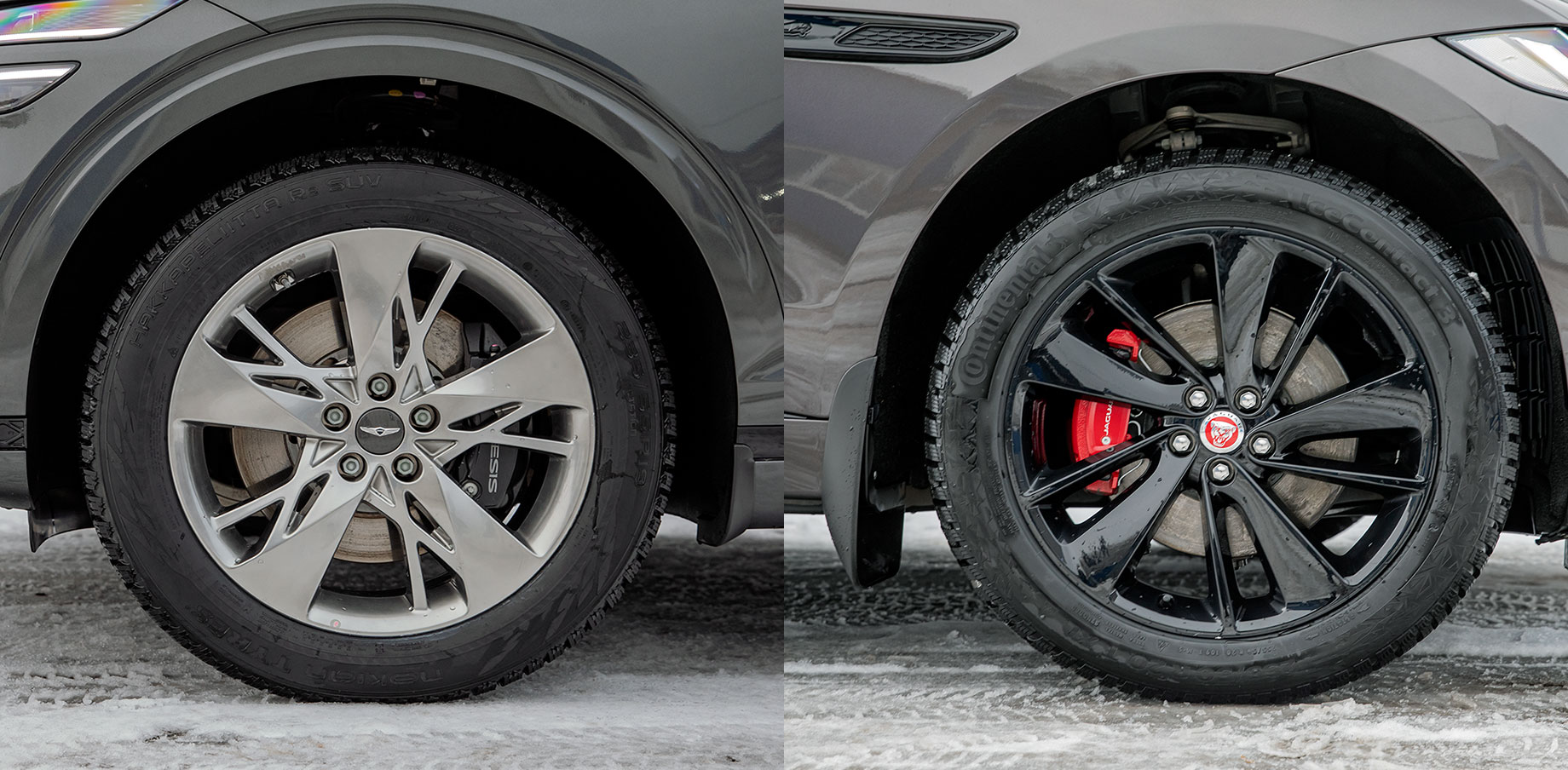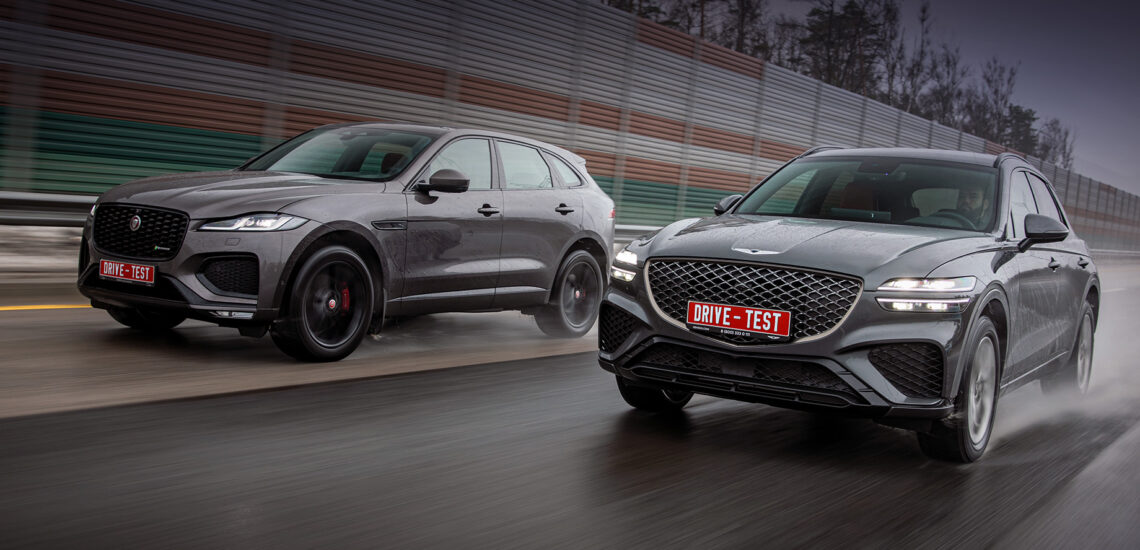Comparison of the Genesis GV70 crossover with the unpopular Jaguar is not from a good life. The Russian office of Audi refused to give an updated Q5: they say, it is not worth it for him to participate in comparison with the “Korean”. We encountered this position during the life of the purchased Stinger. You can’t count on the participation of the Mercedes GLC because of the cool relations with the representative office. A restyled BMW X3 would have been provided to us, but there is still no such one in the press park. The new Lexus NX has just been announced.
Since the higher forces protect the GV70 from meeting sturdy competitors, we use its appearance as an occasion to get acquainted with the upgraded Jaguar F-Pace crossover. It was given not only a utterly different interior, but also a new generation four-cylinder diesel engine Ingenium 2.0 with a capacity of 199 hp. The same amount was removed from the Korean unit of a larger working volume of 2.2 liters.
The first surprise is that the Genesis GV70 is built worse than the Jaguar. At the factory, they could not even install the rear bumper, which has different gaps on the left and right at the junction with the fenders. There are lop-sided gaps between the hood and front fenders. It is generally accepted that the British make cars either before the weekend or straight after them, but the F-Pace does not give reasons for jokes.

Despite his respectable age, it looks cool, especially in a spectacular sporty R-Dynamic with extended black trim on the outside. The Genesis is also equipped with the Sport package, but its corporate design is only fragmentary good. And when you look in general, your eyes notice the heavy car stern and rather big 19-inch wheels lost in large arches.
The interior evokes mixed feelings: either it is the Oval Office, or the VIP lounge in the red-light district… Seriously, I like it even more than the G80 or GV80. In terms of assembly culture and the quality of finishing materials, the “seventy” is not inferior to them, but surpasses them in ergonomics. The uncomfortable swivel ring recessed into the central tunnel has been replaced by a full-fledged controller washer. It can be confused with the AGB rotary selector, but this is the best of a bad lot.
You don’t have to worry about the cleanliness of the trousers — like the Jaguar, the rocker panels are securely covered with doors. You need to take care of your head — tilted racks are not averse to slap you. The driving position is close to optimal — it is not too high, not too low. The seats are more comfortable than in the same “eighties” due to the less curved back, but, as it was there, the massage device, the pillow extension, as well as the adjustment of the lateral support are only for the driver.
Jaguar offers both front riders a rich set of electric drives, sports seats hold better in the area of the shoulder blades, head rests are more comfortable. The F-Pace makes up for the smaller range of lengthwise seat adjustment in the driver’s seat by pushing the steering wheel further out. Although, in general, the landing geometry is so similar that with closed eyes, cars can only be distinguished by smell. Each has its own, but invariably expensive.

After restyling, it’s not a shame to sit in the Jaguar — the interior is expensive both in appearance and to the touch. But if the makers of Genesis paid attention even to the calibration of the force on the buttons, then the British do not attach any importance to this. The climate control temperature adjustment rings play, the buttons on the steering wheel are pressed indistinctly, the touch keys do not work at the first try. And try to cope with the speed control member of the gearbox, which easily jumps from one mode to another.
Is it any wonder that the new multimedia system with a cool picture and a rich set of functions is slow, periodically reboots on the go and stutters when connected using the Apple CarPlay or Android Auto protocols? Genesis has no such problems. But there are smaller ones: you need to reach for a widescreen display, there is no choice of menu design options, the basic font is small, and the larger one looks sloppy.
Turbodiesel 2.2 is noisier and more vibration-loaded than Ingenium. But how powerfully, without delay, the two-ton GV70 starts! It feels like I’m riding a BMW B57D30! The tachometer needle, like in Aston Martin, flies towards the speed indicator — the second gear gets out to 37,29 miles/h, I wait to continue in the third… But as soon as the eight-speed automatic turns on the third, the dynamics sags, although there is no obvious step between the gear ratios. And the treasured hundred is achieved only on the fourth! As a result, Racelogic fixes 8.7 seconds — only 0.4 seconds worse than the declared time.
Genesis picks up energy from low to medium speeds and does not lose enthusiasm on the highway, where any overtaking is easy. The groovy character is supported by a responsive accelerator, which in the sport mode of the power unit is sensitive and linear in reactions. The gearbox with its timely downshifts also works for the common cause.
The aluminum F-Pace is 242,51 lbs lighter, and yields quite a bit in torque (430 N•m versus 441), but the spurt to 100 km / h lasts longer — 8.9 seconds. By this time, Jaguar also manages to move to fourth, although the nature of acceleration is different: starting sluggishly, the F-Pace gets down to business in a couple of seconds for real. Like the GV70, the F-Pace is more impressive on the move, but sours earlier on the highway.

The gas pedal is initially configured sprawlingly. Extended reactions are good in traffic, but annoying otherwise. The Jaguar is transformed when you switch to Dynamic driving mode and support it with a separate sport mode of the ZF eight-speed. In it, the gearbox runs faster and holds the current stage for a long time, so that when the fuel is re-applied, the response is faster.
The Jaguar really uncovers itself when the asphalt begins to twist. Even on the most difficult high-speed section with waves, cross slopes and bumpy surfaces, the Jaguar with the adaptive dampers clamped down rushes excitingly and steadily. It responds quickly to the slightest deviations of the informative steering wheel, under the gas it turns inside the turn, but it does it more willingly under the reset. And the brakes that seemed sluggish in the city on deserted winding paths turn into an accurate and efficient tool.
But we are in the Moscow region, and not on the Isle of Man. When you slow down, the Jaguar seems to hide in a cage and look at the world with dimmed LED eyes. This is where a bunch of problems pop up. On wheels that are not the largest for themselves, the F-Pace lays hard. But even worse, on urban bumps, the suspension work is inurbane. Shocks and bumps are accompanied by vibrations of unsprung masses, to which body vibrations are added from side to side.
The Korean crossover, however, is not softer. It tracks the microprofile and the short wave even more accurately, it is harder for it in deep holes, which lack energy intensity. But on hard surfaces, the move is generally nobler. The passive suspension is monolithic, works quietly, better resists artificial bumps and joints. Parasitic vibrations from the wheels do not come to the floor, the body and suspension work together.
With the Genesis, it’s not as fun to thread corner after corner at a frantic pace due to the unnatural effort on the slightly heavy handlebars, but in less extreme conditions the GV70 is surprisingly good. Responsive, accurate as can be on soft friction tires. They also endowed the Korean SUV with a clear oversteer. But the slip of the rear wheels is so easy to control and stop if necessary, that the “seventy” on a slippery surface turns into a fun car.

This Genesis, unlike the vague “eighties”, has a character. A classy landing in a firmly stuffed chair, a combative power unit, a dense chassis and tenacious brakes create an image that is tough in every sense without a shadow of pretense. This makes the GV70 the best modern Genesis for me, especially given the reasonable prices and the ability to buy a car for them in an online showroom. But with such a nasty ride comfort and inhospitable second row, it can’t become the best in the class.
The GV70 falls short of refined same class Germans, but competes on equal terms with the Jaguar. Although the Genesis is not as good here as the F-Pace is pale. On Russian roads, it feels uncomfortable and makes its passengers feel the same, and a high level of engineering is exposed only in unprecedented conditions for the target audience. Have you seen a lot of F-pace owners rushing headlong along the local B-roads? Infrequently you will meet them rushing along a broken-down grader, where Jaguar conquers with energy intensity.
At times like these, the F-Pace seems like the better choice. For the sake of fun, which takes an hour, I am ready to endure the stiffness of the suspension and the endfloating details of a beautiful interior for days. It is too bad that the Coventry crossover doesn’t have more time to fix its flaws. This is how we will remember it before the arrival of a fully electric successor — bright, unbalanced and less desired. And the Genesis still has everything ahead, and at least the smoothness of the ride comfort can be tightened up.
This is a translation. You can read the original here: https://www.drive.ru/test-drive/genesis/jaguar/61b88771769f9a3e3a7c6248.html

Published March 03, 2022 • 9m to read



